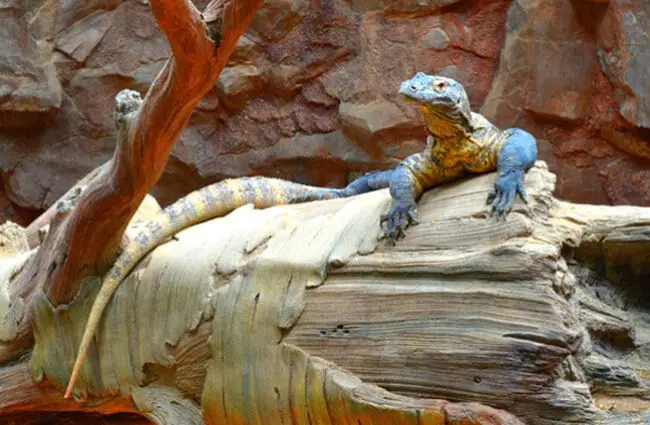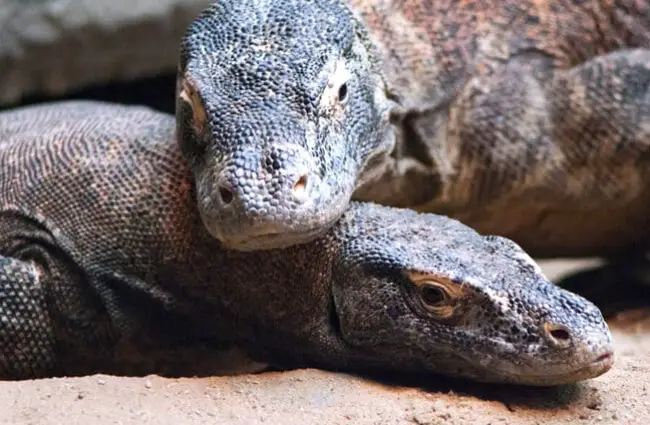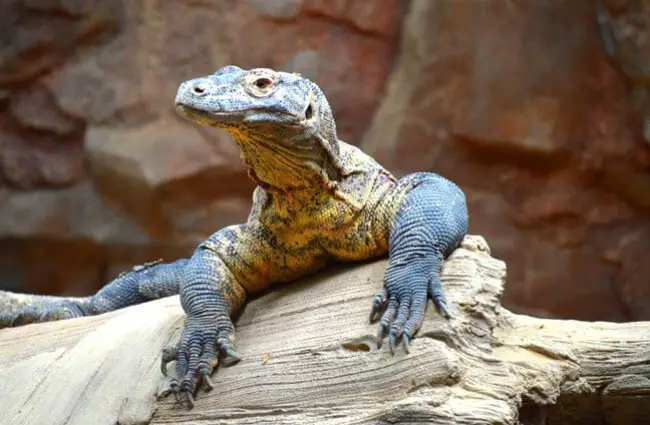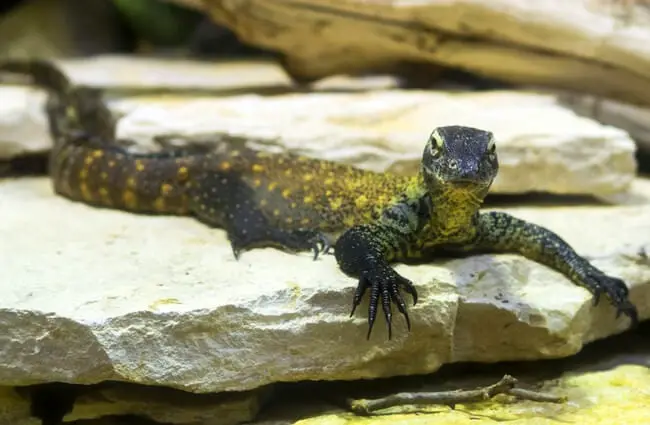Deep in the Indonesian archipelago, a creature of myth and legend roams the sun-baked islands. It is a living relic, a magnificent predator whose very existence evokes images of primeval Earth. This is the Komodo Dragon, Varanus komodoensis, the largest lizard on the planet, a true marvel of evolution that continues to captivate scientists and enthusiasts alike. From its ancient lineage to its complex behaviors, the Komodo Dragon offers a window into a world both fearsome and fascinating.

Unveiling the Dragon: Basic Biology and Habitat
The Komodo Dragon is an undeniable heavyweight in the reptile world. Adult males can stretch an impressive 8.5 feet (2.6 meters) in length and weigh over 200 pounds (90 kilograms), though some individuals have been recorded at even greater sizes. Females are typically smaller, reaching around 6 feet (1.8 meters) and weighing about 150 pounds (68 kilograms). These formidable lizards boast rough, scaly skin that ranges in color from dull gray to reddish-brown, often with a mottled pattern that provides excellent camouflage in their rugged environment. Their powerful, muscular bodies are supported by short, bowed legs, ending in five-toed feet equipped with long, sharp claws. A thick, muscular tail, nearly as long as their body, acts as a counterbalance and a formidable weapon.
Komodo Dragons are native to a small cluster of islands in Indonesia’s Lesser Sunda chain. Their natural habitat is restricted to Komodo, Rinca, Gili Motang, Nusa Kode, and a small coastal area of Flores. These islands are characterized by hot, dry climates, with savanna grasslands, tropical dry forests, and mangrove swamps. They are primarily terrestrial, preferring open, arid environments, but are also adept swimmers and can climb trees when young. They often dig burrows up to 9 feet (2.7 meters) deep with their powerful claws, providing shelter from the intense sun and a place to rest.
Where to Find the Dragon in the Wild
For the intrepid animal lover hoping to witness these magnificent creatures in their natural environment, a journey to Komodo National Park is essential. This protected area encompasses the main islands where Komodo Dragons thrive. Access is strictly controlled, and visitors are required to be accompanied by experienced park rangers. This not only ensures the safety of the visitors but also minimizes disturbance to the dragons. Guided tours are the only way to observe them, typically involving treks through the park’s varied terrain. Remember, these are wild, powerful predators, and respectful distance and adherence to guide instructions are paramount.

An Ancient Lineage: Evolution and Adaptation
The Komodo Dragon’s evolutionary history is as captivating as the creature itself. Belonging to the monitor lizard family (Varanidae), its ancestors are believed to have originated in Asia before dispersing to Australia. The Komodo Dragon’s lineage can be traced back millions of years, with fossil evidence suggesting a close relationship to the extinct giant monitor lizard, Megalania prisca, which roamed Australia during the Pleistocene epoch. As sea levels rose and fell, populations became isolated on the Indonesian islands, leading to the evolution of the distinct Komodo Dragon we know today. This isolation, coupled with the absence of larger mammalian predators, allowed them to grow to their impressive size, a phenomenon known as insular gigantism.
The Apex Predator: Diet and Hunting Strategies
As the apex predator in its ecosystem, the Komodo Dragon’s diet is diverse and opportunistic. They are carnivores, consuming almost any meat they can overpower or scavenge. Their menu includes:
- Deer
- Wild boar
- Water buffalo
- Monkeys
- Goats
- Birds and their eggs
- Smaller Komodo Dragons (cannibalism is common, especially among adults preying on juveniles)
- Carrion (they possess an exceptional sense of smell, capable of detecting decaying flesh from miles away)
Their hunting strategy is a masterclass in patience and power. Komodo Dragons are ambush predators, lying in wait along game trails, camouflaged perfectly within the undergrowth. When prey approaches, they launch a sudden, explosive attack, using their powerful jaws and serrated teeth to inflict deep, tearing wounds. Unlike many predators, they do not rely solely on a quick kill. Their bite delivers a potent cocktail of venom, containing anticoagulants and toxins that induce shock, lower blood pressure, and prevent clotting. This venom, combined with the bacteria from their saliva, weakens the prey, often leading to death within hours or days. The dragon then patiently tracks its ailing victim, sometimes for miles, until it succumbs. This unique combination of mechanical injury, venom, and bacterial infection makes them incredibly efficient hunters.
The Dance of Dragons: Mating and Reproduction
Komodo Dragon reproduction is a fascinating and sometimes brutal affair. Mating season typically occurs between May and August, followed by egg-laying in September. Males engage in fierce combat for the right to mate, wrestling each other upright until one is pinned to the ground. The victor then approaches the female, often using a series of tongue flicks to assess her receptiveness.
- Courtship: Males will rub their chins on the female, scratch her back, and lick her. If she is receptive, she will allow him to mount her.
- Nesting: Females lay clutches of around 15 to 30 leathery eggs in underground nests, often in abandoned megapode mounds or self-dug burrows. These nests provide insulation and protection from predators.
- Incubation: The eggs incubate for approximately 7 to 8 months. The mother often guards the nest for the first few months, but eventually leaves, making the hatchlings vulnerable.
- Hatchlings: Young Komodo Dragons, measuring about 16 inches (40 cm) long, are immediately independent. They spend their early years living in trees to avoid predation by larger Komodo Dragons and other ground predators. Their diet consists of insects, small birds, and other small reptiles.
- Parthenogenesis: One of the most astonishing aspects of Komodo Dragon reproduction is their ability to reproduce asexually through parthenogenesis. This means a female can lay fertile eggs without any genetic contribution from a male. This rare phenomenon has been observed in captive Komodo Dragons and is a remarkable adaptation that allows isolated females to establish new populations.

Guardians of the Ecosystem: Role and Interactions
As the apex predator on their islands, Komodo Dragons play a crucial role in maintaining the health and balance of their ecosystem. They are nature’s clean-up crew, consuming carrion and preventing the spread of disease. By preying on large herbivores like deer and wild boar, they help regulate populations, preventing overgrazing and promoting biodiversity. Their presence influences the behavior and distribution of other animals, shaping the entire food web.
Dragons and Humans: Interaction and Conservation
Cultural Significance
For the local people of the Komodo islands, the dragons are more than just animals; they are deeply intertwined with local folklore and culture. Known as “Ora” or “land crocodile,” they are revered and sometimes feared. Legends speak of the dragons as ancestral spirits or mythical beings, leading to a complex relationship of respect and caution.
Encountering a Komodo Dragon in the Wild: What to Do
While rare, an encounter with a Komodo Dragon outside of a guided tour can be dangerous. These animals are powerful and unpredictable. If you find yourself in such a situation:
- Stay Calm: Panic can provoke an attack.
- Do Not Run: Komodo Dragons can run surprisingly fast in short bursts (up to 12 mph or 20 km/h). Running may trigger their predatory instinct.
- Back Away Slowly: Maintain eye contact and slowly retreat, making yourself appear as large as possible.
- Avoid Sudden Movements: Quick actions can be perceived as a threat.
- Do Not Approach: Never attempt to feed, photograph up close, or interact with a wild Komodo Dragon.
- Seek Higher Ground: If possible, climb a sturdy tree or rock. Young dragons can climb, but adults are generally too heavy.
- If Attacked: Fight back aggressively. Aim for the eyes or snout. This is a last resort for survival.
Conservation Challenges
Despite their fearsome reputation, Komodo Dragons are classified as an endangered species. Their limited geographic range makes them particularly vulnerable to environmental changes and human activities. Key threats include:
- Habitat Loss: While protected, human encroachment and development on some islands can reduce their available habitat.
- Prey Depletion: Poaching of deer, wild boar, and other prey animals directly impacts the dragons’ food supply.
- Climate Change: Rising sea levels threaten their coastal nesting sites, and changes in temperature could affect egg incubation.
- Illegal Trade: Although strictly protected, there is a persistent threat of illegal trade for their skins or as exotic pets.
Conservation efforts, primarily led by the Indonesian government and international organizations, focus on protecting Komodo National Park, managing tourism, and combating poaching. Education and community involvement are also vital to ensuring the long-term survival of these magnificent lizards.

Caring for Dragons: Insights for Zookeepers
Caring for Komodo Dragons in captivity is a specialized and demanding task, requiring extensive knowledge and strict safety protocols. Zookeepers play a crucial role in conservation through breeding programs and public education.
Enclosure Design and Environment
- Spaciousness: Enclosures must be exceptionally large to accommodate their size and activity levels, mimicking their natural range.
- Substrate: A deep substrate of sand, soil, and leaf litter allows for digging and burrowing behavior.
- Temperature and Humidity: Precise environmental controls are essential. Temperatures typically range from 80-90°F (27-32°C) with basking spots reaching 100-110°F (38-43°C). Humidity should be moderate to high.
- Water Features: A large, clean water pool is necessary for drinking, soaking, and defecation.
- Enrichment: Providing logs, rocks, varied terrain, and rotating scents or objects encourages natural behaviors like climbing, exploring, and hunting.
- Security: Enclosures must be escape-proof and robust, with multiple layers of security to prevent accidental escapes and protect staff.
Diet and Feeding
- Variety: A varied diet is crucial, typically consisting of whole prey items like rabbits, chickens, rats, and fish.
- Frequency: Adults are usually fed once or twice a week, while juveniles require more frequent meals.
- Supplements: Calcium and vitamin supplements are often added to ensure proper nutrition.
- Safety: Feeding is a high-risk activity. Zookeepers use long tongs and strict protocols to ensure their safety and the dragon’s well-being.
Health and Veterinary Care
- Regular Check-ups: Routine physical examinations, blood work, and fecal analyses are vital for monitoring health.
- Parasite Control: Regular deworming and parasite checks are necessary.
- Dental Health: Monitoring for dental issues is important due to their powerful bite and prey consumption.
- Behavioral Monitoring: Observing changes in behavior can indicate health problems.
What to Avoid
- Direct Contact: Never handle an adult Komodo Dragon without extreme caution and specialized equipment. Their bite is incredibly dangerous.
- Underestimation: Never underestimate their speed, strength, or intelligence.
- Inadequate Enclosures: Small or poorly secured enclosures are a recipe for disaster.
- Monotonous Diet: A lack of dietary variety can lead to nutritional deficiencies.
- Lack of Enrichment: Without stimulation, dragons can become lethargic or develop stereotypical behaviors.
Fascinating Facts About the Komodo Dragon
- Exceptional Sense of Smell: They use their long, forked tongues to “taste” the air, picking up scent particles that are then analyzed by a specialized organ in the roof of their mouth, the Jacobson’s organ. This allows them to detect prey from several miles away.
- Powerful Swimmers: Komodo Dragons are surprisingly good swimmers and can cross short stretches of water between islands.
- Tree Climbers: While adults are too heavy, juvenile Komodo Dragons are agile climbers, spending much of their early lives in trees to escape cannibalistic adults and other predators.
- Long Lifespan: In the wild, Komodo Dragons can live for up to 30 years, and even longer in captivity.
- Venomous Bite: For years, scientists debated whether their bite was purely septic or venomous. Research has confirmed the presence of venom glands producing toxins that cause rapid blood loss and shock.
- Bone-Crushing Jaws: Their jaws are incredibly powerful, capable of tearing flesh and crushing bones. They can swallow large chunks of meat whole.
- Slow Metabolism: Like many reptiles, Komodo Dragons have a slow metabolism, allowing them to survive on infrequent, large meals.
- Solitary Nature: Except during mating season, Komodo Dragons are largely solitary animals.

Conclusion: A Legacy to Protect
The Komodo Dragon stands as a testament to the enduring power of nature and the incredible diversity of life on Earth. From its ancient origins to its role as an apex predator, every aspect of its existence is a story of adaptation and survival. As a species facing increasing pressures, its future depends on continued conservation efforts and a deeper understanding from humanity. By appreciating and protecting these magnificent “living dragons,” we ensure that future generations can also marvel at a creature that truly belongs to a world of wonder.

![Red Angus Closeup of a beautiful Red Angus cowPhoto by: U.S. Department of Agriculture [pubic domain]https://creativecommons.org/licenses/by/2.0/](https://animals.net/wp-content/uploads/2020/03/Red-Angus-4-238x178.jpg)




![Red Angus Closeup of a beautiful Red Angus cowPhoto by: U.S. Department of Agriculture [pubic domain]https://creativecommons.org/licenses/by/2.0/](https://animals.net/wp-content/uploads/2020/03/Red-Angus-4-100x75.jpg)

